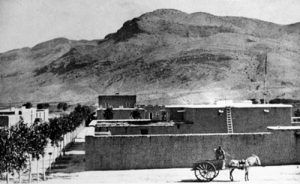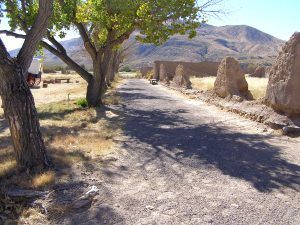
Fort Seldon, New Mexico, 1875
Established on the Rio Grande at what is now Radium Springs, New Mexico, Fort Seldon was built in 1865 to protect settlers and travelers in the Mesilla Valley of New Mexico from outlaws and Apache Indians. Troops were ordered from Albuquerque to the site to begin construction in April 1865. Soldiers and some civilian workers soon began constructing adobe, flat-roofed, one-story buildings that would serve as barracks for one company of infantry and another company of cavalry. An Administration Building was also constructed. The wagon from the Rio Grande hauled water and stored in large water barrels. Fort Selden’s commander also established several picket posts. Ten troops of the Third Cavalry were stationed at Aleman Station, the halfway point on the Jornada del Muerto route between Las Cruces and San Marcial. This small post also served as a stage station, post office, and, later, a telegraph office.
Another picket post was established at San Augustine Pass, a gap in the San Andres Mountains between Las Cruces and White Sands. Considered a dangerous place where livestock was often stolen, and several civilians were killed, the commander wrote in 1869: The San Augustine Pass is regarded by all as the most dangerous place in this section of New Mexico.
The nearest town of Leasburg, then filled with saloons, brothels, and violence, was placed off-limits to the soldiers. Desertion was always a problem at Fort Selden, especially after their pay was cut in 1870. Post chores were monotonous and sometimes demeaning, and there was very little to do.
The post was inhabited by Buffalo Soldiers of the 9th Cavalry and the 21st, 38th, and 125th Infantry during its duration. These African American troops were seen as fierce by the Indians and were not as apt to desert as their white counterparts.
In 1882, Fort Bliss in El Paso, Texas, was expanded, and Fort Selden began to decline. By 1888, the last full company of troops left the post. Two years later, it was turned over to the Interior Department in February 1890. A small detachment remained at the post as caretakers until January 1891, when they were pulled out, and the property was sold.
The site was declared a New Mexico State Monument in 1974 and is open to visitors today. Numerous ruins of the post’s buildings continue to stand, and the Visitor’s Center displays exhibits depicting life at the fort, including 19th-century military weapons, uniforms, archaeological artifacts, and rare photographs of the U.S. Army in the West. Living history demonstrations are occasionally offered on summer weekends.
By Kathy Alexander/Legends of America, updated February 2024.
Also See:

